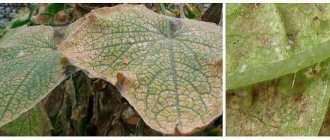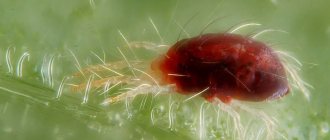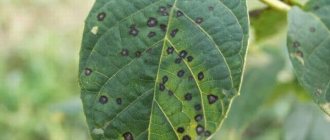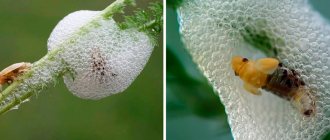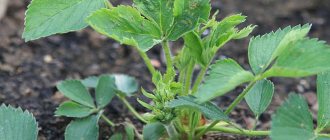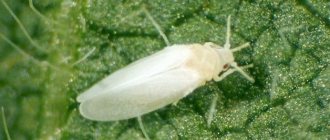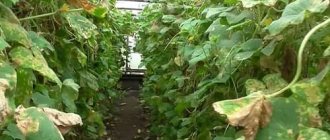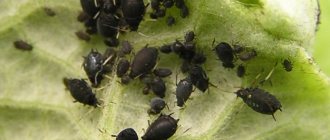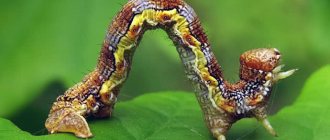The common spider mite or Tetranychus urticae is one of the main pests of nightshade crops. In particular, the arachnid parasite poses a danger to peppers, both seedlings and adult plants. The phytophage gnaws through tissue and draws juice from young leaves and shoots. The plant stops developing, withers and dies. In order not to be left without a harvest, every vegetable grower should know what spider mites look like on peppers and how to deal with them.
Spider mite: description of the pest
What does a spider mite look like on a pepper: photo
Many gardeners often mislead themselves by agreeing with the statement that spider mites are an insect pest. In fact, spider mites are arachnids that can only be seen under a magnifying glass. The body length of an adult female spider mite is only 0.4 millimeters, and males do not reach such sizes, so they cannot be seen with the naked eye, but traces of their presence are very obvious.
Spider mites are sucking arachnids, their color depends on what time of year they spread, as well as what they feed on. With their stylets, spider mites can pierce the leaf blade and suck out the cell sap from it until the plant loses its vitality and drops the infected leaves. Populations spread very quickly, and this can happen in several ways:
- females migrate with the wind when the weather is appropriate, and they do this thanks to the web they weave
- mites can crawl from one plant to neighboring ones simply on the soil
- Ticks can also cling to human clothing or animal fur, and then land on completely different parts of the area.
Which plant seedlings are most often affected?
Spider mites are a problem not only for garden crops, but also for indoor flowers. Suffering from infection:
- Zucchini, melons and watermelons. Loss of leaves from sunburn leads to reduced yield.
- Sugar snap peas and beans. The pods are attacked.
- Garden roses.
- Indoor flowers (fuchsia, pelargonium, orchid). Spider mites create aesthetic problems. Large populations kill plants.
- Seedlings of cucumbers, tomatoes and eggplants.
- Fruit trees (grapes, peaches, nectarines).
- Young cabbage bushes.
- Strawberries and wild strawberries.
Spider mite: life cycle
What does a spider mite look like on a pepper: photo
It is interesting to consider the life cycle of a spider mite. As soon as it settles on the plant, the female begins to very actively draw juice from the plant, and also produces an ideal web. She also lays eggs under it, making an ideal shelter so as not to harm her children. Under favorable temperature conditions, larvae and nymphs soon develop from a clutch of eggs, but this requires both temperature and sufficient air humidity, otherwise the eggs will simply die by drying out. The larvae mature in about 25 days, or even less. In one season, an average of 18 generations of spider mites grow, and all of them, of course, if no preventive measures are taken, then in the future they simply spread to the entire area, destroying the crop along the way, in particular the pepper crop.
The web is of great importance for their life. It can mark the boundaries of several dozen colonies that settle on plants, and the very necessary microclimate is created in the web so that the larvae develop faster and more actively. Only female mites and eggs go to winter, and in general, at this stage of the life cycle, there is a pause in the life activity of spider mites - they stop feeding, developing, they are generally in a stage called diapause. Ticks overwinter in cracks in the bark of trees, as well as in wooden structures that seem safest and most suitable to them.
Prevention
Prevention of spider mites on peppers comes down to the following measures:
- soil disinfection during planting;
- periodically examining the leaves of the seedlings with a magnifying glass;
- maintaining humidity in greenhouses at a level of at least 60%;
- compliance with crop rotation, exclusion of proximity to nightshades and cucumbers;
- regular weeding or mulching of the soil;
- burning all plant residues from the garden or greenhouse at the end of the season.
If a mite has already appeared on a pepper, it is extremely difficult to fight it. Following simple rules of agricultural technology will help avoid “acquaintance” with the pest.
Sources
- https://misterklop.ru/klesshi/kak-borotsya-s-pautinnym-kleshhom-na-pertse-v-teplitse-i-na-otkrytom-grunte
- https://SuperUrozhay.ru/bolezni-i-vrediteli/kak-borotsya-v-domashnix-usloviyax-s-pautinnym-kleshhom-na-rassade-perca.html
- https://safari-34.ru/kleshchi/pautinnyj-kleshch-na-perce-2.html
- https://superda4nik.ru/pautinnyj-kleshh-na-perce/
- https://zelenplaneta.ru/kleshhi/pautinnyj-kleshh-na-pertse.html
- https://agronom.expert/posadka/ogorod/paslenovye/perets/pautinnym-kleshhom-na-rassade.html
- https://percevod.ru/bolezni/pautinnyj-kleshh-na-pertse
- https://KlopSOS.ru/pautinnyj-kleshh/na-perce/
[collapse]
Spider mites on pepper seedlings: how to detect the pest?
What does a spider mite look like on a pepper: photo
There are several signs by which you can immediately understand that spider mites have affected peppers, and they need to take measures to combat this pest. Ticks pierce the plant, so you can notice uncharacteristic spots on the leaves, which are also called “marbling of the leafy part.” Over time, the dots begin to reunite, merge, and the tissues acquire an unhealthy brown tint. Webs also appear on leaves and stems as the mite moves through the plant. Parts of the plant that are too tightly woven with cobwebs begin to lose their vitality and dry out very actively. This may occur because the quality of photosynthesis decreases and leaf transpiration progresses. If a plant is very badly affected by spider mites, then its yield can be reduced by about 60%, and this is a fatal indicator.
There are several main reasons why spider mites appear on pepper seedlings and spread very quickly throughout the bushes. The first reason is that there is a high air temperature outside or in the greenhouse. Mites become active when the temperature reaches about twenty degrees. The intensity of reproduction increases as it gets hotter. The second reason is low humidity levels. Spider mites thrive in dry air, and the optimal humidity may not exceed 40%. The third reason for the proliferation of spider mites on peppers is that the plants may be experiencing the most obvious water stress. If there is a lack of water in the plant tissues, then soluble carbohydrates begin to be produced in the leaves, and this is what increases the fertility of mites. There is another reason. Its essence lies in the fact that the gardener gives the plants too much nitrogen-containing fertilizer. If the plant is overfed with nitrogen, it attracts mites even more, and also affects the weight of females, the intensity of fruiting and the condition of the eggs.
In protected ground, the spider mite shows its maximum activity, since it is there that all the most favorable conditions exist for its development, vital activity and, of course, reproduction. Since vegetable peppers in most regions of our country are grown in greenhouse conditions, the fight against ticks takes first place in central Russia, the Urals and Siberia. However, in the southern parts of the country and in open ground, peppers come under attack from mites.
Whitefly
Elderly people and gardeners with poor eyesight may find it difficult to detect whiteflies on their property. Despite the striking appearance of the adults (4 snow-white wings of the insect seem to be sprinkled with flour), the whitefly is a secretive and cautious pest. The length of its body (light yellow color) is only 3-5 mm, and most of the time it hides on the inside of the leaves. Inexperienced gardeners often confuse whiteflies with moths, which for some reason run very quickly if touched, and only then take off. Insect larvae are even smaller and look like transparent blisters or growths.
Peppers are attacked by the greenhouse whitefly. It is discovered by chance - you can, for example, shake a leaf and see a swarm of small midges that take off and begin to circle around the plants. The inside of the leaves becomes sticky and becomes covered with small light spots - these are traces of parasite secretions (honeydew or honeydew). In this nutrient medium, a fungus multiplies, which leads to oppression of the leaves, they become white and yellow (as in chlorosis), and then suddenly turn black and die. Thus, the cause of the death of pepper is not the insect itself, but the fungal and infectious diseases it carries and causes (powdery mildew, mosaic, gray rot).
Measures to combat whitefly:
|
Spider mites on peppers: how to fight?
What does a spider mite look like on a pepper: photo
There are several ways in which you can fight spider mites so that they do not have time to destroy the entire crop and move to new crops. Akarin is a drug that belongs to a subtype of intestinal acaricides. During the first eight hours after the drug was applied to the plant, the mites are immobilized and are unable to feed, which is why they die very quickly. It is worth keeping in mind that Akarin is very dangerous for bees.
- Apollo is a selective contact acaricide that can sterilize adults very quickly. Eggs and nymphs die very quickly and have no chance to develop further. Unlike Akarin, Apollo is completely safe for bees. The third drug, Actellik, belongs to the group of non-systemic insectoacaricides. It acts not only against ticks, but also against many other pests, and the essence of the action is that the drug enters the gastrointestinal tract of the tick and kills it from the inside, since the pest simply cannot feed. Dangerous for bees.
- Dicofol 20% is a low-toxic acaricide that affects the tick through its intestinal system. Effective both against adults and against eggs and nymphs, completely safe for bees. Another drug is Kleschevit. This is an insectoacaricide that also affects the pest through the gastric and intestinal tract. As soon as the substance enters the pest’s body, it causes paralysis, as a result of which the tick cannot move, feed normally, and dies after some time. The drug is also very dangerous for bees, and this should be kept in mind when purchasing.
Why is it dangerous?
First of all, spider mites lead to disturbances in the metabolic processes of the plant.
Pest attacks are accompanied by the following negative consequences:
- weakening of seedlings due to moisture deficiency (the mite sucks out all the beneficial substances from the bush);
- the web interferes with the process of photosynthesis;
- the plant’s immunity weakens, and as a result it is susceptible to various infectious diseases;
- Peppers affected by mites are susceptible to mosaic and mycoplasma.
As a result, the activity of the pest has a detrimental effect on the bush and can destroy the entire crop, so the mite should be dealt with immediately. The sooner the fight begins, the better the prospects.
Folk remedies
What does a spider mite look like on a pepper: photo
It is important for every gardener to know that spider mites quickly adapt to various chemical acaricidal preparations. Therefore, you cannot use the same product several times in a row - it is best to alternate products, increase and decrease doses, but do this in accordance with the instructions for use. In addition to such chemicals, which are sold in specialized stores for gardeners, there are also some folk remedies that are also quite effective against ticks.
Folk remedies for fighting spider mites on peppers are practically safe for humans, and they will allow the gardener to save his money. For example, plants can be washed with a solution of laundry soap. Of course, it is impossible to completely get rid of spider mites using this remedy, but its populations will be noticeably reduced, and this is already a huge plus, because in this case small doses of chemical acaricides can be used.
Alcohol treatment of the plant - the leaves must be wiped with a damp sponge. Alcohol should not be diluted with water or other solutions, otherwise it will lose its effect and will dry even longer and cause burns on the tender leaves of peppers. Due to the fact that alcohol is an expensive product, it is best to use it in small areas where plantings are located. Gardeners also prefer to spray peppers with a decoction based on henbane. To do this, about three kilograms of fresh raw materials are cut, boiled for three hours, then filtered and diluted in a bucket. Peppers should be sprayed. Tobacco decoction is also excellent for spraying peppers, since the corresponding aroma of the decoction repels many pests. Garlic tincture has the same properties; you can also add a certain amount of laundry soap to it to enhance the effect. Thanks to folk remedies, you can achieve very good results, especially if the spider mite has not yet had time to seriously infect the plant. Also, these decoctions are quite safe, so they can be used not only after mite infestation of peppers, but also for preventive purposes.
Of course, there are ways by which spider mites can be successfully dealt with without endless spraying. To do this, the gardener uses an integrated approach, which consists of exactly two key components: these are measures that will increase the plant’s immunity, as well as the use of natural enemies that will allow them to cope with a wide variety of diseases without special physical, time and, of course, material costs . It is possible to breed ticks against their own natural enemies, but not all gardeners use this method, in truth, only a small part of them. Mites of other species - phytoseiulus - are very effective in the fight against spider mites. These are the same predatory arachnid mites that feed on spider mites. Populations are sold directly in bottles where they are mixed with sawdust or vermiculite. In one bottle there are about two thousand individuals that are ready to fight spider mites.
This type of mites should be used in this way: conditions are created in the greenhouse under which the humidity rises to almost 80%, mites are poured from the bottle into special applicators with holes made, and these structures are hung directly on the stems or between pepper bushes. It is worth remembering that these mites do not live very long, so you should use the bottle immediately after it has been purchased and opened.
Ants
We are used to admiring these highly organized creatures exactly until the moment they begin to harm our crops and supplies. Garden ants are attracted to the secretions of aphids and the pepper plantings themselves are interesting to them. Ants become “shepherds,” guarding aphids on plants and feasting on their juice. Accordingly, it is impossible to defeat aphids without eliminating a colony of thousands of ants.
Ants and aphids do not like to camouflage themselves - plant stems clinging to them immediately become noticeable. In general, the harm caused by ants comes down to the breeding and “exploitation” of aphids, although they themselves regularly spoil plantings, destroy beds and flower beds and do not disdain plant sap. If ants come to the site, get ready for a protracted war.
Measures to combat ants:
|
Stimulants
What does a spider mite look like on a pepper: photo
In order to increase the resistance of the plant and its immunity, you can use some popular stimulants. Mival-agro is a drug that belongs to the type of organosilicon biostimulants. This preparation contains a fairly powerful adaptogen and antioxidant, thanks to which peppers strengthen their resistance to external attacks, and for this reason their condition improves quite quickly, and this is a huge plus for the gardener. The second drug is Immunocytophyte - this stimulant is based on arachidonic acid, which allows peppers to adapt faster and more successfully after the seedlings have been planted in open ground. In addition, resistance to fungal and viral diseases improves. Epin-extra is one of the most famous drugs that is presented on the Russian market today. Thanks to it, peppers can more successfully resist various stressful situations, temperature changes and even frost. Carvitol is a bioregulator that combines the properties of not only a biological stimulant, but also an adaptogen and fungicide. It increases the plant’s resistance to various external factors and irritants, improves the appearance of the bushes and their vital processes.
There are several mistakes gardeners make when trying to control spider mites on peppers. The first mistake is that gardeners use a large number of insecticides. Spider mites are not insects, so insecticides against them are completely useless and ineffective. Secondly, when a gardener uses the same drug repeatedly, ticks can adapt to its effects, develop immunity and stop perceiving it as a killer. The third mistake is that the gardener often does not prepare the greenhouse for the soil in the best way. After the planting season has ended, it is necessary to disinfect the greenhouse, wash it and remove any plant debris. It is also best to immediately treat the soil with acaricidal preparations. Thus, the fight against spider mites on peppers and their seedlings will be most effective if the gardener uses some preventive measures and also monitors the health of the peppers. In addition, it is best to objectively evaluate lesions on plants, because in often cases it is best to get rid of the affected bush, since it will no longer be possible to revive it
Preventive measures
To save time and money, it is better to take the following preventive measures in time:
- In the fall, remove all fallen leaves and plant debris from the garden.
- Dig up the soil and treat with an acaricide.
- Remove all weeds in a timely manner.
- Carry out regular watering.
- Carry out preventive spraying with acaricidal chemicals or folk remedies.
- Maintain humidity in the greenhouse at 60-70% and temperature up to 25⁰C (these conditions are unfavorable for the reproduction of spider mites).
- At the end of the season, wash and disinfect the greenhouse, remove plant debris, treat the soil with sulfur bombs.
- Plant peppers next to garlic and onions, as tetranych mites avoid them.
Other types of mites
Do you want to surprise us more? There are mites that do not spin webs, and the presence of a pest is even more difficult to determine. In addition to the usual spider mite, the following types are also found:
| red | prefers roses, nightshade, orchids, lemons, impatiens, cacti | like the spider mite, it multiplies rapidly at high temperatures |
| Atlantic | colonizes indoor palm trees and citrus fruits, but easily spreads to other plants | one of the few mites that actively spread when indoor humidity is high |
| false | completely invisible to the naked eye, since it is very small, downright microscopic | does not weave webs, so the lesion is noticed only when the plant begins to die |
| cactus flat (bryobia) | affects Saintpaulia, Fatsia, can spread to any other plant | can be detected by white-yellow intermittent stripes on the leaves; The female lays large orange eggs in a chain along the leaf vein |
| clover | found on abutilons, euonymus, peperomia, ficus, orchids and various bulbous plants | eats away entire passages, filling them with brown dust |
| wide | settles on anthuriums, ficuses, saintpaulias, euonymuses, oleanders, citrus fruits and cacti | very prolific - new colonies “break out” on the leaves of the infected plant every 3-4 days, they are quite easily detected: red clusters of dust and cobwebs are visible; At the same time, females do not hide in hard-to-reach places to lay eggs, so it is a little easier to deal with |
| cyclamen | spreads on balsams, violets, gloxinias, chrysanthemums, cyclamens, pelargoniums | lives not only on leaves, but also in tubers; numerous colonies look like a layer of dust; unlike other ticks, they prefer high air humidity |
| strawberry | parasites become active in open ground in strawberry beds by the end of July - beginning of August | loves warm and rainy weather, during the season 7-9 generations of pests grow in the affected area; significantly reduces the winter hardiness of plantings |
In conclusion, I would like to note that although it is difficult to promptly identify the presence of a tick based on its symptoms - the webs are difficult to see, and the tick itself is too small - it is much easier to deal with than a whitefly
